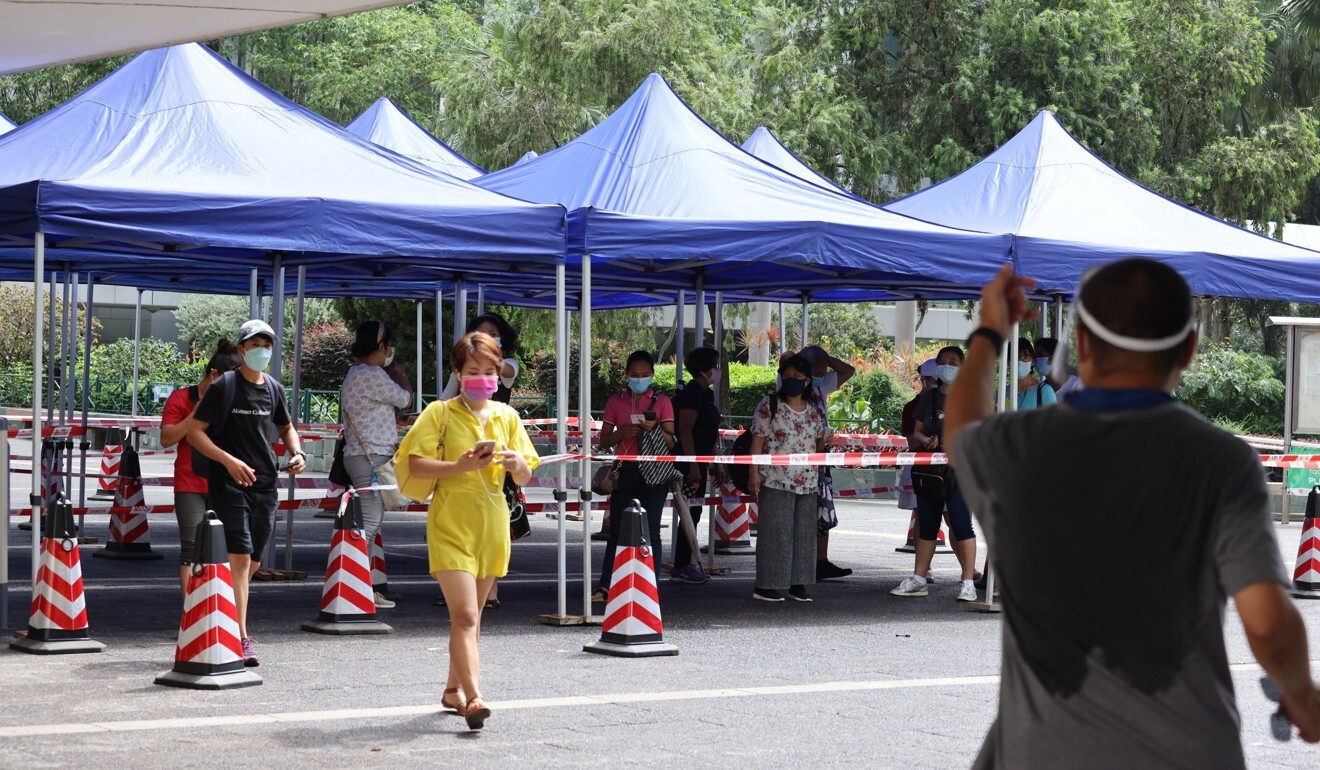
Coronavirus: Hong Kong in quick U-turn over placing neighbouring Guangdong province on list of ‘medium-risk’ Covid-19 areas
- Hongkongers would no longer have been allowed to cross the land border and enter the city through the quarantine-free ‘Return2HK’ programme
- City confirms one infection, deemed as likely to be imported from Indonesia, while another preliminary-positive case involving migrant worker causes concern
The about-face was announced in a government statement hours after officials said the province would be added to the list following a recent outbreak of the coronavirus in the Liwan district.
Centre for Health Protection officials told a regular Covid-19 press briefing that Guangdong would be joining Anhui and Liaoning provinces on the list, meaning Hongkongers would no longer be allowed to cross the land border and enter the city through the quarantine-free “Return2HK” programme, though they could still arrive on flights or via Macau.
The development came as the city on Saturday confirmed just one Covid-19 infection, deemed as likely to be imported from Indonesia. However, another preliminary-positive infection involving a migrant worker who had been in the city since mid-February could put an end to a week-long streak of zero untraceable local cases.
The government said it was assessing the situation with its Guangdong counterpart.
“The planned Return2HK arrangements will remain unchanged for the time being, and any changes will be announced later,” a government spokesman said.
The statement clarified that while three places including Liwan in Guangzhou city had been adjusted to a “medium-risk area” at present, the province was not classified as such.
Former chief executive Leung Chun-ying had earlier hit out in a Facebook post at the idea of halting the cross-border arrangement purely because of cases in Liwan.

Meanwhile, Hong Kong’s run of untraceable infections was being closely watched, as the government previously said it would strengthen or weaken its hand in negotiations with mainland Chinese authorities on getting the border fully reopened.
The government announced late on Friday that all residents of towers 5A and 5B at Cullinan West in Sham Shui Po had to be screened after a helper who lived there tested preliminary-positive, sparking concerns the city’s zero infection record had been blemished again.
Dr Chuang Shuk-kwan, head of the Centre for Health Protection’s communicable disease branch, on Saturday confirmed the 29-year-old helper’s infection, but said she was likely to have caught the virus in Indonesia.
Hong Kong travel bubble with mainland China may be just ‘weeks away’
According to Chuang, the patient arrived in Hong Kong on April 25, on a flight where three other passengers seated far from her were later found to be virus carriers. Upon arrival, she quarantined at the Grand City Hotel in Sai Ying Pun, where she tested negative for the virus on the 12th and 19th day of her stay.
Last Sunday, she finished quarantine and visited a private diagnostics centre and a helper agency before going to her employers’ home at Cullinan West. Since then, she had only left home to walk a dog once or twice, and had no contact with others.

“There is quite a low chance of this being a community infection, as she had only left the hotel for a few days,” Chuang said, adding the patient already carried antibodies to the coronavirus, meaning her infection could not have been recent. Antibodies usually take 10 days or more to develop.
It was also unlikely a spread had occurred in the quarantine hotel, as no one on the helper’s floor was infected and all staff tested negative in the most recent screening.
Altogether, about 18 close contacts including the family the helper worked for had to undergo quarantine, Chuang said.
Fewer than five people tested preliminary-positive citywide, but one case caused particular concern.
Chuang said another migrant worker from Indonesia, who arrived in the city via Singapore on February 20, spent more than a month living in her new employer’s flat at Earl Gardens in Ho Man Tin and four days in accommodation arranged by an agency in Block B of Bell House in Yau Ma Tei.
Both buildings would be placed under mandatory testing orders, and those who were in the blocks from May 9 to Saturday would have to undergo screening by Tuesday.
The health official said the case was likely to be an untraceable local infection, adding 11 close contacts had so far been identified.
“This signifies there are still some hidden transmissions in the community. It is quite difficult to achieve zero cases in the community, because there were quite a number of asymptomatic infections in the past, they would generate chains of transmission,” Chuang said.
Getting vaccinated was the “ultimate tool” to maintain infections at a low level, she said.
The overall tally of confirmed cases stood at 11,830, with 210 related deaths.
Global virus deaths up to three times higher than official figures: WHO
Meanwhile, infectious disease expert Professor Yuen Kwok-yung revealed to the Post he found no trace of the coronavirus from environmental samples collected from a Tsing Yi clinic where a recent four-year-old patient had obtained his testing kit.
The boy’s infection, at one time thought to be a false positive but later confirmed by Yuen, was key to ascertaining whether Hong Kong had gone a month without untraceable cases in the community.
Yuen, a government pandemic adviser, said the latest results, based on 10 samples taken from the clinic’s refrigerator and injection and office tables, as well as the storage place for testing kits, showed the possibility of contamination of the boy’s samples there was slim.
He reiterated his belief the child caught the virus from fellow residents in Pak Tin Estate back in January, meaning the city has had no newly acquired untraceable infections for 29 days.
Additional reporting by Kanis Leung and Rachel Yeo

